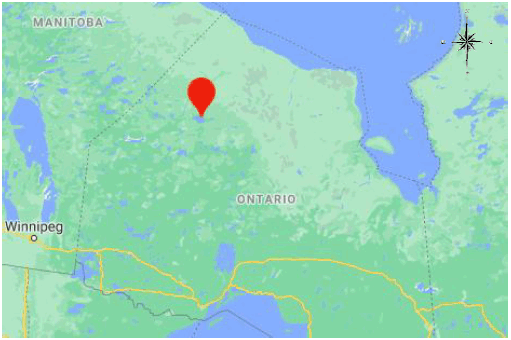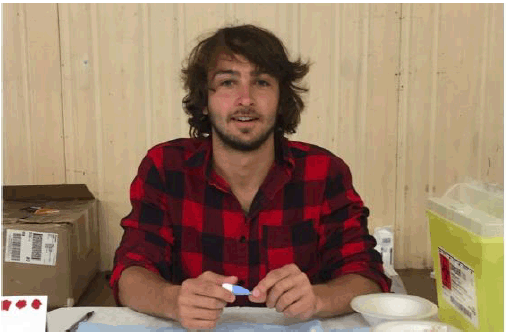Map of Ontario Depicting the Location of Kitchenuhmaykoosib Inninuwug First Nation.

Legend: Source, Google Maps®
Sebastian R. Diebel1
doi: http://dx.doi.org/10.5195/ijms.2021.936
Volume 9, Number 1: 86-87
Received 31 01 2021: Rev-request 17 02 2021: Rev-recd 03 03 2021: Accepted 04 03 2021
Northern Ontario (NO) is a geographically vast land that is located in the province of Ontario in the country of Canada. In order to provide perspective, it is the size of Germany and France combined, yet possess a comparatively minute population of 840,000 people.1 The Northern Ontario School of Medicine (NOSM) was created in 2005 and was the first new medical school created in Canada in over 30-years.1 The school was created using a unique approach that involved engaging community stakeholders with the key concept of social accountability in mind.2 Social accountability as it pertains to medical schools is the idea that the medical institution has an obligation to direct the education, research, and services that they are instructing towards addressing the needs of a community, region, and nation that they are serving.2 The social accountability mandate highlighted the importance of serving the population of NO, including Francophone (individuals who speak French) and Indigenous populations. Indigenous populations represent approximately 4.4% of the population of Canada, however, when looking at a NO context the population is approximately 23% in the Northwest and 11% in the Northeast regions of Ontario.2 As a result, NOSM, in collaboration and partnerships with Indigenous stakeholders created an Indigenous health curriculum that involves didactic learning, as well as a mandatory cultural competency placement for a one-month period of time in an Indigenous community that takes place at the end of the first year of studies.3 The following is my experience of a one-month cultural competency placement in the Oji-Cree community of Kitchenuhmaykoosib Inninuwug (KI) First Nation, also known as Big Trout Lake in English (Figure 1). The First Nation of KI is a remote community that has a population of approximately 1200 people. The community is located south of the Hudson Bay on the shores of Big Trout Lake and does not have road access.4
Figure 1Map of Ontario Depicting the Location of Kitchenuhmaykoosib Inninuwug First Nation.

After an entire day of travel, my classmate and I were sitting on a small airplane looking down into the vast landscape of NO. As we began to approach the First Nation community of Kitchenuhmaykoosib Inninuwug various thoughts were going through my head. Although I was familiar with some First Nation communities, I had never been to an Oji-Cree community. As a result, I sat pondering. What would the community be like? What language would people be speaking? What are the health needs and challenges of this community? Before I knew it, we had landed on the dirt runway and had arrived in Kitchenuhmaykoosib Inninuwug.
After we landed, we were able to find a community member to drive us from the airport to our accommodations, a modest little building that was not far from the community school. Shortly after we established our rooms, we did not have any direction as to what our next day would look like. The following day, we woke up, attended our distributed learning session, and shortly after presented ourselves to the community nursing station. Although the nursing station was not expecting us, they quickly made us feel at home. We were integrated into the operations quickly. This involved speaking with doctors who locum in the area, attending appointments with patients, and performing procedures such as phlebotomy, obtaining vital signs, and shadowing physicians during medical appointments. As a first-year medical student this was the first patient contact that I had experienced in the role of medical student. It is interesting to note that the first patient interactions I had in my medical school career may also be the most unique in both a cultural and rural manner. Culturally, I was exposed to a wide range of patient preferences. Some patients were open to Western medicine, whilst others were more hesitant and preferred some traditional methods of healing. From a rural standpoint, it is of note that the nursing station did not have any diagnostic imaging available. This adds an entire new layer of complexity to the paradigm of care as patients need to board an airplane and go to the community of Sioux Lookout located 426 kilometers to the south. By observing the physicians and being a part of interactions, I gained an appreciation for the importance of a thorough physical exam and making difficult clinical decisions. As a person, it made me feel grateful for having lived in areas with easy access to medical care. As a student it made me eager to want to continue my studies and continue to learn more about medicine in a clinical context.
Outside of medicine, we were able to spend time with community members and learn about the culture and traditions of the community. Personally, I found the distribution of language to be interesting as it appeared to me that the elders in the community almost exclusively spoke Oji-Cree, whereas the younger generation appeared to be fluent in both Oji-Cree and English. As we were not from the community, some community members were curious as to who we were and what we were doing there. The curiosity quickly led to members being friendly and welcoming. Some members were excited that we were present and insisted that they show us around their community. They were very proud of the community and what it had.
Although the crux of this placement was of a cultural nature, my classmate and I were able to participate in a pan-community Hepatitis screening project with a PhD researcher from the University of Toronto (Figure 2). My involvement in this activity afforded me the opportunity to understand medicine from a cultural point of view that I had never experienced before. I had discussions with individuals that had a completely non-western view on medicine and preferred to speak in heir Oji-Cree language. To me this was an experience that I will remember and take with me for the rest of my medical career. I particularly found it interesting that many participants stated to myself and the team that they attended because it was asked of them to benefit their entire community. Their Chief and Council had requested for every individual to be tested for the safety of the community and almost everyone complied, even if they personally may not have benefited, as they knew it was best for their community. I found this to be very interesting and it was explained and apparent to me that everyone coming together for the benefit of the entire group, a collectivist ideology, was very much ingrained within the culture. I believe this cultural ideology of collectivism can be transferred to the larger exterior population and it made me want to think more about the importance of global and public health with the need to benefit the many and not just the few.
Figure 2Me Assisting in the Pan-Community Screening Event.

The experiences that I gained during this cultural competency placement were extremely unique and advantageous in keeping with the spirit of reconciliation.5 Although there is still much work to be done, Canada has recognized the injustice that Indigenous peoples have faced. Currently, attempts towards reconciliation between the Government of Canada and Indigenous populations are underway.5 I am pleased that I attend a school that works in the spirit of reconciliation.
I thoroughly enjoyed my placement in the Oji-Cree community of Kitchenuhmaykoosib Inninuwug. I gained insight and perspective that involved feeling humbled and thankful, all of which was done in the spirit of reconciliation. The transferable lessons for both myself and the broader medical community involve the need to remain culturally sensitive and humble in order to best serve Indigenous communities. This is particularly true for anyone studying medicine in countries with colonial legacies such as Australia, Canada, and the United-States.3
I am fortunate to attend a school that is rooted in social accountability and has a strong desire to improve the health of the various populations it serves including Francophone and Indigenous populations. I have taken life-long lessons with me and I believe that students who wish to serve Indigenous populations should spend time during their formative training to understand the intricate cultural workings that are at play. This is an experience that I will take forward through the remainder of my medical journey.
The author wishes to thank the community of Kitchenuhmaykoosib Inninuwug First Nation.
The Authors have no funding, financial relationships or conflicts of interest to disclose.
Conceptualization, Writing – Original Draft Preparation: SRD. Writing – Review & Editing: SRD.
1. Strasser RP, Lanphear JH, McCready WG, Topps MH, Hunt DD, Matte MC. Canada's new medical school: The Northern Ontario School of Medicine: social accountability through distributed community engaged learning. Acad Med. 2009 Oct;84(10):1459–64
2. Strasser R. Delivering on social accountability: Canada's Northern Ontario School of Medicine. The Asia-Pacific Scholar. 2016;1(1):1–6.
3. Jacklin K, Strasser R, Peltier I. From the community to the classroom: The Aboriginal health curriculum at the Northern Ontario School of Medicine. Can J Rural Med. Fall 2014;19(4):143–50
4. Peerla D. No means no: The Kitchenuhmaykoosib Inninuwug and the fight for Indigenous resource sovereignty. Available at SSRN 2189897. 2012 Dec 15.
5. Niezen R. Truth and indignation: Canada's Truth and Reconciliation Commission on Indian residential schools. University of Toronto Press; 2017 Nov 15.
Sebastian R. Diebel, 1 BSc, MSc, EMCA, Northern Ontario School of Medicine, Canada
About the Author: Sebastian Diebel is a current third year medical student, Northern Ontario School of Medicine, Sudbury (East Campus). Prior to medical school Sebastian completed an undergraduate degree at The University of Mount Olive, Mount Olive, North Carolina, USA and received a full athletic scholarship. Following that he completed a master's degree from Lakehead University, Thunder Bay, Ontario, Canada. During his master's degree he published work on runners and altitude training in international journals. He is also a certified paramedic in Ontario (attended Collège Boréal, Sudbury, Ontario, Canada) and holds an Emergency Medical Care Assistant (EMCA) certification in the province of Ontario.
Correspondence: Sebastian R Diebel, Address: Northern Ontario School of Medicine, Canada. Email: sdiebel@nosm.ca
Editor: Francisco J. Bonilla-Escobar Student Editors: Annora Kumar Copyeditor: Nikoleta Tellios Proofreader: Leah Komer Layout Editor: Anna-Maria Chantaliyska
Copyright © 2021 Sebastian R. Diebel
This work is licensed under a Creative Commons Attribution 4.0 International License.
International Journal of Medical Students, VOLUME 9, NUMBER 1, April 2021